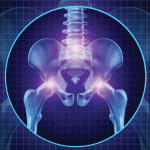Given the concern for septic arthritis, the patient underwent a joint aspiration that revealed only 255 white blood cells, 16% neutrophils, 13,760 red blood cells, and a negative gram stain and culture.
She was subsequently started on vancomycin and piperacillin/tazobactam while results were pending.
Given the non-inflammatory joint fluid, a diagnosis of erosive azotemic osteodystrophy, rather than osteoarthritis, was ultimately made. Antibiotics were stopped.
In discussion with radiology, findings of articular and periarticular erosions of the left hip consistent with erosive azotemic osteodystrophy had been present on a CT of her abdomen and pelvis performed nine months earlier. Her pain was managed with medications, she was seen by a physical therapist and, ultimately, discharged home.
Discussion
Our patient had studies conducted as part of an inpatient evaluation, with findings that mimicked a septic joint.
A study by Karchevsky et al. looked at the radiographic findings most commonly associated with septic joints. This study found that MRI synovial enhancement was present in 98% of septic joints, perisynovial edema in 84%, and joint effusions in 70%.2 The findings in our patient included joint effusions and synovitis, as well as periarticular muscle edema, therefore seemingly consistent with a septic joint. She was started on antibiotics, which were quickly stopped based on the sterile joint aspiration.
Ultimately, the patient’s hip pain was attributed to erosive azotemic osteodystrophy. The latest guidelines recommend against radiographic studies as a means of diagnosing erosive azotemic osteodystrophy due to the lack of consistent findings and correlation with clinical symptoms.
Bone biopsy is the gold standard for making the diagnosis of renal osteopathy and distinguishing its subtype, but is often deferred in clinical practice, with the diagnosis made by trending parathyroid hormone as well as markers of bone turnover, including alkaline phosphatase and C-telopeptide of type I collagen (CTX).3,4 However, radiographic findings associated with renal-related osteodystrophy include periarticular erosions, which may mimic inflammatory arthritis. Joint spaces, however, are generally preserved.4 Most common findings in the sacroiliac joints specifically include poorly defined erosions and articular sclerosis, often symmetrical. These findings were present on our patient’s radiographic studies.5
